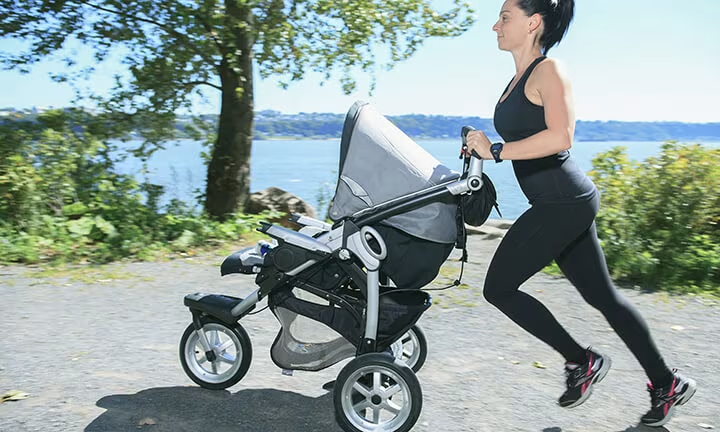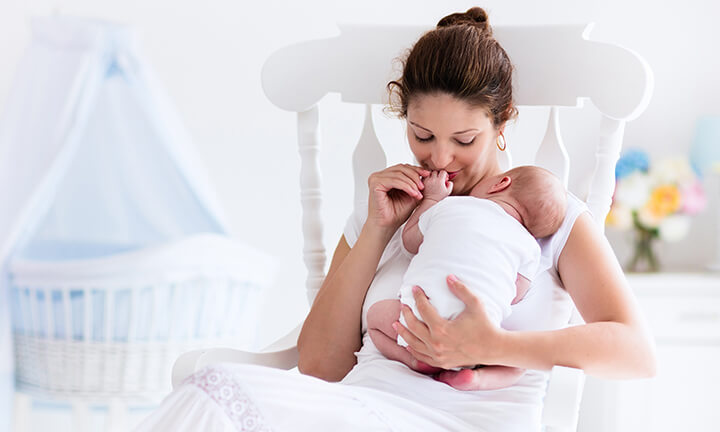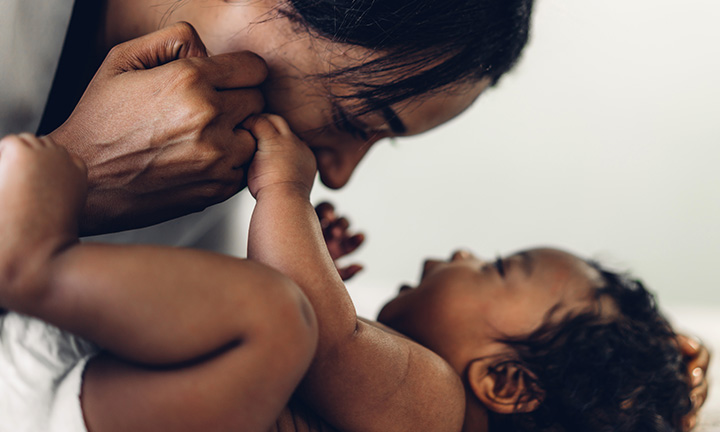
Postpartum Weight Loss


Postpartum weight loss is a common concern for many new moms, but it’s important to approach it with realistic expectations and a focus on your overall well-being. Most people lose about 10 to 15 pounds immediately after birth, and gradual weight loss continues over the following months. Key factors that influence postpartum weight loss include:
Everybody is different, and it’s important to be patient and kind to yourself during this transition. In this article, we’ll explore evidence-based strategies, realistic timelines, and healthy habits to support sustainable postpartum weight loss while prioritizing your physical and emotional health.
Understanding Postpartum Weight Loss
Before beginning your postpartum weight loss journey, it's helpful to understand where your pregnancy weight gain actually comes from. While indulgent cravings (like that nightly bowl of ice cream!) may contribute, much of the weight is due to essential biological changes that support your baby’s development.
Here's a typical breakdown of where pregnancy weight goes, according to the American College of Obstetricians and Gynecologists (ACOG):
These changes are necessary to support your pregnancy and prepare your body for labor and breastfeeding.
Your recommended pregnancy weight gain varies based on your pre-pregnancy Body Mass Index (BMI), whether you're carrying twins, and your general health. The Centers for Disease Control and Prevention (CDC) and ACOG suggest that most women gain between 25 and 35 pounds during a healthy singleton pregnancy, but this number can vary.
Factors like regular prenatal exercise and a balanced pregnancy diet can influence how much weight you gain and how much you may need to lose postpartum. For personalized guidance, always consult your healthcare provider about what's healthy for your body before, during, and after pregnancy.
How Much Weight Do You Lose After Giving Birth?
The good news? You’ll likely lose a noticeable amount of weight immediately after delivery. On average, new parents lose about 13 pounds (6 kg) right after giving birth—thanks to the baby, placenta, and amniotic fluid.
In the first week postpartum, many shed another 5 to 8 pounds (2 to 3.5 kg) as their body naturally eliminates retained fluids, like excess blood and water weight. Some people lose up to 20 pounds (9 kg) within the first few weeks after delivery.
However, postpartum fat loss takes more time. Fat accumulated during pregnancy doesn’t disappear overnight. The average weight loss after birth slows down after the initial weeks and can take 6 to 12 months to return to your pre-pregnancy weight.
Health experts recommend aiming for 1–2 pounds of weight loss per week after giving birth. This pace is generally safe, especially if you’re breastfeeding and gradually returning to physical activity.
Remember, your body needs time to heal after giving birth. Rather than rushing to “bounce back,” focus on rest, recovery, and self-compassion. Growing and delivering a baby is an incredible feat, and your body deserves care and patience during this transition. Consult your healthcare provider at your 6 week post-birth appointment for more advice.
How Many Calories Do You Burn Giving Birth?
Labor and delivery are physically demanding processes that require significant energy expenditure. While specific calorie counts can vary based on individual factors such as the duration and intensity of labor, it's important to recognize that childbirth is a strenuous activity—just one more reason to give your body grace after delivery!
Rapid Weight Loss After Pregnancy and Childbirth
While it might be tempting to aim for rapid weight loss after pregnancy, it’s important to understand the potential risks and red flags. Losing weight too quickly after childbirth can strain your body, impact your milk supply if you're breastfeeding, and could even signal an underlying health issue.
If you're experiencing sudden or unexplained weight loss in the weeks after giving birth—especially without trying—it’s essential to speak to your healthcare provider. It could be a sign of:
A gradual, balanced approach to losing weight postpartum is recommended by experts. Prioritize nourishing meals, hydration, rest, and gentle physical activity approved by your provider.
Avoid extreme diets or intense exercise routines in the early postpartum period. Instead, focus on healing and building healthy habits you can maintain over time.
How to Lose Weight After Pregnancy
Losing weight after pregnancy is a gradual process that involves balancing calorie intake with physical activity. Combining healthy eating habits with regular postpartum exercise over several months can help shed the extra pounds gained during pregnancy. Instead of trying to find the quickest way to lose weight after having a baby, it's important to approach this journey with patience and self-compassion, recognizing that each person's experience is unique.
Postpartum Nutrition: What to Eat
Proper nutrition is crucial during the postpartum period to support recovery and provide energy, especially if you're breastfeeding. Avoid weight loss crash diets or drastic calorie restrictions postpartum, as your body needs sufficient nutrients to heal and function effectively. If you’re wondering what to eat after childbirth, focus on a balanced diet that includes:
Limiting intake of sugary snacks, processed foods, and high-sodium items can also aid in weight management. If you're uncertain about your dietary needs, consult with your healthcare provider or a registered dietitian for personalized guidance.
Working Out Postpartum
Working out postpartum not only supports weight loss but also boosts your mood, energy, and overall well-being—benefits that are especially helpful during the early days of parenting. Once you've had your postpartum checkup, your healthcare provider can advise you on when to start exercising after giving birth, especially if you had stitches or a C-section.
Some parents are ready for gentle activity just a few days after a vaginal delivery, while others may need several weeks—particularly after a cesarean or more complex birth. Always listen to your body and start slowly following your doctor’s guidance.
Here are some tips to safely ease into a postnatal fitness routine:
Remember, how long after birth you can workout depends on your personal recovery. Be kind to yourself, take it at your own pace, and celebrate small milestones as you rebuild strength and confidence. Read our dedicated article for even more postpartum workout ideas and tips.
Breastfeeding and Weight Loss
If you're wondering about losing weight while breastfeeding, here's some encouraging news: breastfeeding can actually support gradual postpartum weight loss. As your body produces milk, it burns extra calories, drawing from both the food you eat and the fat stores built up during pregnancy.
Breastfeeding parents burn an estimated 300 to 500 extra calories per day, depending on how often they nurse. This calorie burn from breastfeeding can contribute to weight loss over time, especially when combined with healthy eating and gentle postpartum exercise.
That said, balance is key. Rapid or extreme weight loss while breastfeeding—such as through crash diets or major calorie restrictions—can impact your milk supply and leave you feeling depleted. Your body still needs sufficient energy to make quality breast milk and support your own recovery.
To stay on track, aim for a breastfeeding diet that supports both you and your baby. This includes:
Losing weight after pregnancy doesn’t have to mean sacrificing your breastfeeding goals. Focus on nourishing yourself, being kind to your body, and letting breastfeeding and weight loss work together—safely and naturally.
Download our Go-To Breastfeeding Guide today for everything breastfeeding-related, from nutrition tips to positions and your very own printable breastfeeding tracker.
More Tips: Postpartum Rest, Hydration, Self-Care, and Support
While healthy eating and postpartum exercise are key strategies for losing weight after pregnancy, your body also needs adequate rest, hydration, support, and sometimes professional intervention to fully recover. Here are some essential tips to help support your overall well-being and long-term postpartum weight loss.
FAQS AT A GLANCE
Most people lose around 13 pounds (6 kg) right after childbirth, which includes the baby’s weight, as well as the weight of the amniotic fluid and placenta. When it comes to fat loss, with a healthy diet and regular exercise, you may lose about 1 pound (0.5 kg) a week. It may take up to a year to get close to your pre-pregnancy weight.
The Bottom Line
Your postpartum journey is unique, and there's no "one-size-fits-all" approach to recovery or weight loss. Focus on progress, not perfection, and surround yourself with supportive people who encourage your well-being. Whether it’s a partner, a friend, a lactation consultant, or your healthcare provider—don’t hesitate to reach out for help when you need it.
The key is to be patient with yourself and your body. Eat well and exercise because it makes you feel great, and focus on how amazing your baby is, as well as all the good things in your life right now. Your postnatal well-being is as important as the number on the scales, so be kind to yourself and give your body enough time to adjust.
Another thing you’re likely focusing on during your postpartum period is all those diaper changes. Get a little help by downloading the Pampers Rewards app to earn Pampers Cash on all your purchases.
- American College of Obstetricians and Gynecologists. Your Pregnancy and Childbirth: Month to Month, 6th ed. (Washington, DC: American College of Obstetricians and Gynecologists, 2015).
- ACOG: Interpregnancy Care
- CDC: About Sleep
- CDC: Alcohol
- Cleveland Clinic: Postpartum
- Cleveland Clinic: Postpartum Thyroiditis
- Cleveland Clinic: What to Expect After Giving Birth
- Mayo Clinic: Breastfeeding nutrition: Tips for moms
- Mayo Clinic: C-section recovery: What to expect
- Mayo Clinic: Postpartum care: What to expect after a vaginal birth
- Mayo Clinic: Postpartum Depression
- Mayo Clinic: Weight loss after pregnancy
- Mayo Clinic: Women’s Wellness: Breastfeeding and weight loss
- National Library of Medicine: Effects of Experimental Sleep Restriction on Weight Gain, Caloric Intake, and Meal Timing in Healthy Adults
- La Leche League International: Weight Loss While Breastfeeding
- Womens Health: Recovering After Birth
- Cleveland Clinic: Exercise After Delivery
- Mayo Clinic: Postpartum Depression







